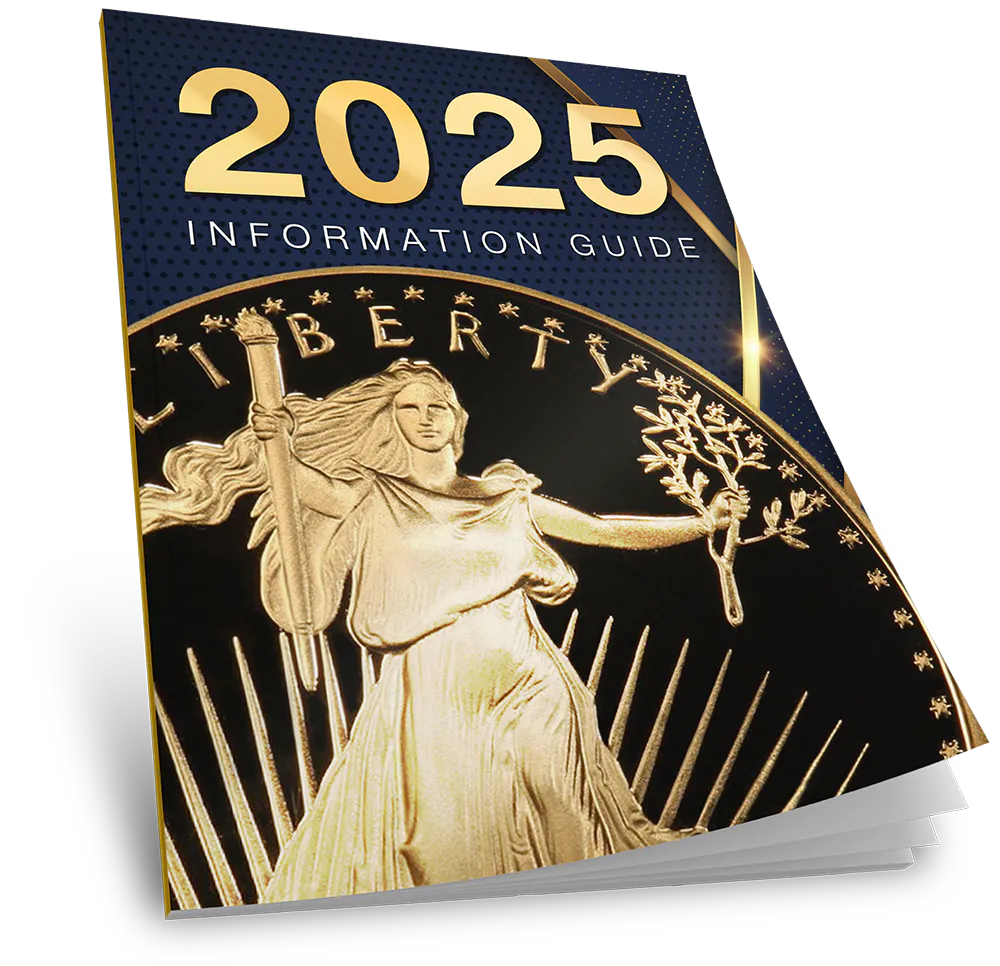A potential collapse of the U.S. dollar can stir uncertainty and prompt many to seek safer places for their wealth. In times of economic turmoil, acquiring precious metals like silver becomes a compelling option. Silver’s value may rise significantly if the dollar collapses due to its role as a tangible asset and diverse industrial applications.
The strength of the U.S. dollar directly influences the value of silver. When the dollar weakens, silver often gains value, making it a reliable store of wealth. As currency devaluation occurs, people seek stability, and precious metals provide that security. Alongside gold, silver stands out as a practical choice, offering an accessible way to preserve wealth.
In scenarios where the dollar’s value plummets, our wealth preservation strategies should include acquiring both silver and gold, perhaps through a Gold IRA.
Let’s take a more in-depth look at how silver’s value could change if the U.S. dollar were to collapse.
What Is the Value of Silver in a Dollar Collapse?
When the U.S. dollar weakens significantly, silver’s value often increases. This section covers historical examples and the role of silver as a stable store of value.
Historical Precedents and Lessons
In the past, when currencies collapsed, silver prices often rose.
For example, during periods of hyperinflation, such as in Germany in the 1920s and Zimbabwe in the 2000s, silver retained its value when national currencies did not.
In Germany, the price of silver increased by over 1000% during the hyperinflation period. These historical events demonstrate that silver can be a reliable asset in times of economic uncertainty, providing a stable anchor in turbulent financial seas.
Another key instance is the U.S. economic struggles during the 1970s and early 1980s. Despite fluctuations, silver prices surged alongside inflation concerns. Understanding these historical precedents, where silver has consistently retained its value during economic turmoil, helps us gauge silver’s potential stability during a dollar collapse.
Silver as a Store of Value
Silver, valued for centuries due to its versatility and industrial uses, stands as a stable store of value. Unlike paper currency, which can lose value due to inflation, silver maintains its purchasing power. Its demand often increases in economic crises, making it a reliable and secure investment choice.
Additionally, acquiring silver bars and coins can be an effective way to preserve wealth. Unlike other assets that may be volatile, silver offers a reliable alternative. For those looking to understand current silver prices, checking updated spot prices per ounce, which represent the current market value of silver, can provide insights into its value.
Acquiring precious metals like silver during economic instability is a strategic choice and a reliable wealth preservation strategy. Its historical and practical role in maintaining wealth stability provides reassurance and preparedness for uncertain economic times.
What To Know About Supply and Demand in Silver Valuation
The value of silver intricately depends on both industrial demand and investor sentiment. These two factors deeply influence the market’s perception of silver’s worth.
Industrial and Manufacturing Demand
Silver has various applications in industry and manufacturing, such as its use in electronics, solar panels, medicine, and even water purification. High demand for silver products in these areas can increase prices due to increased consumption.
The supply side is crucial, too. Mining operations and silver production levels need to meet industrial needs. When supply falls short, prices can rise sharply. Any disruptions in mining can impact availability and push up costs in the global market. Thus, supply and demand play a significant role in price fluctuations.
Investor Sentiment and Market Value
Investor sentiment also shapes silver’s market value. Economic uncertainty can drive more people to acquire precious metals like silver. This increased demand can raise silver prices, reflecting its status as a safe haven.
Understanding market dynamics is crucial for making informed investment decisions. Factors such as investor sentiment and trading volumes significantly influence silver’s market value, particularly during economic downturns. This knowledge empowers investors to understand how sentiment and trading volumes affect market value.
What Are the Benefits of a Precious Metals IRA?
If you’re considering turning to precious metals to help safeguard your finances, here’s what to know about the advantages of a precious metals IRA:
- Protection Against Inflation: Precious metals, including silver, typically hold their value over time. This makes them a reliable option for protecting your savings.
- Economic Security: Silver often acts as a safe haven in times of financial uncertainty. Historical data shows that silver retains its value even when currencies falter. Acquiring silver provides a buffer against market volatility.
- Diversification: Adding silver to your IRA helps spread risk across different asset classes, which is important for balancing your portfolio. A valuable metal like silver can complement traditional assets like stocks and bonds.
- Tax Advantages: Silver IRAs often offer tax benefits similar to those of other IRAs. Contributions may be tax-deductible, and earnings can grow tax-deferred, offering significant savings over the long term.
How To Acquire Silver for IRAs
You need a self-directed IRA custodian to start a Silver IRA. This custodian will manage your account and handle the paperwork. They ensure compliance with IRS regulations regarding precious metals IRAs.
After selecting a custodian, you must open and fund your account. You can transfer funds from an existing IRA or make new contributions. This step is crucial for purchasing precious metals within your IRA.
The IRS has specific requirements for the silver that can be included in an IRA. Typically, these include silver coins and bars of a certain purity. It’s important to choose products that meet these standards.
Once you’ve chosen your silver products, the custodian will finalize the purchase. All silver acquired for an IRA must be stored in an approved depository. This ensures the security and integrity of your assets.
A Gold IRA is another option for diversifying and protecting your retirement savings. Silver and other precious metals offer a reliable alternative to traditional financial assets. If you want to understand more, you can also explore the various benefits of precious metals. Each approach has its own merits, focusing on your financial security and peace of mind.
What Global Economic Factors Influence Silver’s Future Worth?
Global economic conditions can heavily impact the value of silver. Key factors include currency devaluation and geopolitical tensions, both of which can drive significant changes in silver’s market price.
Currency Devaluation and Silver
Currency devaluation can powerfully impact silver prices. Silver often becomes more attractive when major currencies like the US dollar, the euro, or the Chinese yuan lose value. This happens because silver and other precious metals usually hold their value better than paper money during inflation or financial crises.
For example, if the US dollar weakens significantly, the purchasing power of dollar holders decreases. People might then acquire precious metals like silver to maintain their wealth. This increased demand pushes silver prices up. In contrast, similar reactions in the silver market can occur when the Japanese yen or the Swiss franc devalues, affecting global economic stability.
Geopolitical Tensions and International Trade
Geopolitical tensions and international trade dynamics are also crucial. Events like conflicts or significant policy shifts can disrupt global markets. During these times, silver’s status as a safe-haven asset comes into play, driving up its price.
For instance, international trade can suffer if tensions rise between major economies like the US and China, leading to economic uncertainty. This uncertainty often prompts people to acquire silver to safeguard their assets. Additionally, restrictions on trade routes or sanctions can affect the supply chains for silver, impacting its availability and price. This has been observed historically with currencies like the Russian ruble and the euro during periods of political unrest.
How Does Silver Compare to Other Safe Haven Assets?
Silver is often compared to safe-haven assets like gold, real estate, and cryptocurrencies. While gold is typically more popular, silver offers advantages such as lower cost and higher industrial demand. This makes it more accessible to more people looking to protect their wealth.
Real estate is another common choice but requires significantly more capital and management. Cryptocurrencies have also gained popularity, but they are relatively new and can be very volatile. In contrast, silver offers a balanced combination of stability and practical use.
Silver’s Performance in Past Crises
Historically, silver has performed well during economic downturns and periods of high inflation. For instance, during the 2008 financial crisis, silver prices significantly increased as people sought refuge in precious metals.
Silver prices soared in the 1970s, another period of economic instability and inflation. These examples demonstrate how silver can act as a reliable store of value when traditional paper currencies are under threat. This historical performance makes silver a compelling asset for those looking to safeguard their wealth against future uncertainties.
For those interested in diversifying their savings, a Gold IRA includes both gold and silver, ensuring a broader safety net during unpredictable economic times. Silver coins and bars are also widely available options for diversifying without diving deep into metals IRA specifics.
Coins and Bullion as Acquisition Basics
Silver coins and bullion are two primary ways of holding physical silver. Often minted by governments, coins come with a recognized face value but are valued for their silver content. Popular silver coins include the American Silver Eagle and Canadian Silver Maple Leaf. Conversely, bullion comes in bars and rounds and is typically cheaper per ounce than coins.
Coins are often favored due to their recognizability and liquidity. They’re easy to store and can even become collectibles over time. Bullion offers a cost-effective method of acquiring silver in bulk. To safeguard these valuable assets, it’s important to consider storage options for both, such as secure safes or vault services.
What Are Some Future Applications for Silver?
Silver has a pivotal role in many modern technologies and green applications. Its unique properties make it indispensable in manufacturing, industrial applications, and sustainable practices.
Technological Advancements and Silver Usage
Silver is crucial in manufacturing and industrial applications due to its excellent conductivity and antibacterial properties. It’s widely used in batteries, electronic devices, and water purification systems.
Innovative uses for silver are expanding. Due to their superior electrical conductivity, technological innovations rely on silver to produce advanced electronic devices like smartphones and computers.
Silver’s antimicrobial features make it essential in medical tools and coatings. With new discoveries, silver’s usage in various sectors continues to grow, driving its demand in the global market.
The Role of Silver in Green Technologies
Green technologies heavily depend on silver. Solar panels, for example, use a significant amount of silver for their efficient operation. With the push for renewable energy, the demand for solar panels, and thus silver, is increasing rapidly.
Silver is also important in water purification processes — its ability to kill bacteria makes it a key component in filtration systems.
Silver’s role in these technologies highlights its importance as the world shifts towards sustainable practices. The growing trend of green energy solutions will likely keep silver in high demand globally.
The Bottom Line
Purchasing precious metals like silver can safeguard assets if the U.S. dollar collapses. Silver is known for its historical value as a safe haven during economic uncertainty.
Silver has essential industrial uses, which can drive demand even when other markets are unstable. This makes it a unique asset compared to other metals.
Additionally, the global acceptance and ease of transaction make silver an attractive option. When currencies face devaluation, silver often maintains its value.
We should remember the historical trends and the potential for silver to provide a resilient option. Acquiring silver through coins or bars offers a tangible method to secure our wealth against economic fluctuations.
For those considering this route, it’s worth exploring options like a Gold IRA to understand how precious metals can fit into a retirement plan.
Sources:
Silver and gold’s staggering ascent during German hyperinflation of the 1920’s | MINING.COM
Seeking Alpha | Stock Market Analysis & Tools for Investors






